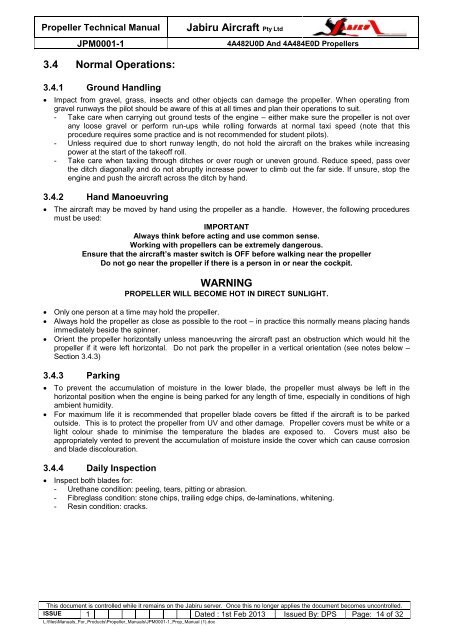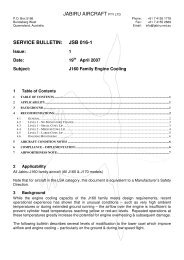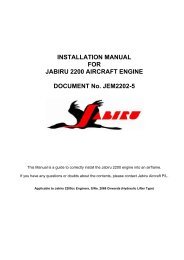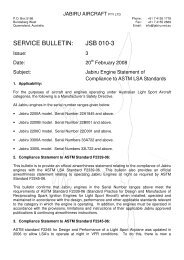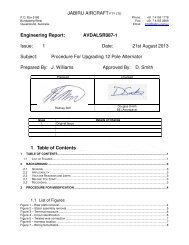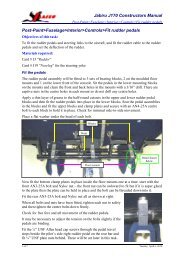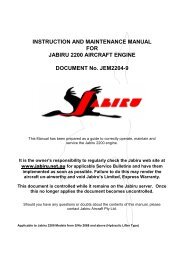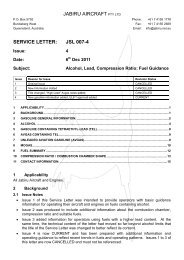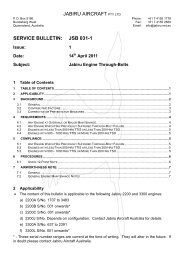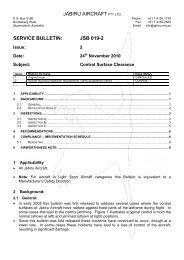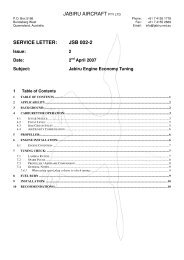Propeller Technical Manual - Jabiru
Propeller Technical Manual - Jabiru
Propeller Technical Manual - Jabiru
Create successful ePaper yourself
Turn your PDF publications into a flip-book with our unique Google optimized e-Paper software.
<strong>Propeller</strong> <strong>Technical</strong> <strong>Manual</strong><br />
JPM0001-1<br />
<strong>Jabiru</strong> Aircraft Pty Ltd<br />
4A482U0D And 4A484E0D <strong>Propeller</strong>s<br />
3.4 Normal Operations:<br />
3.4.1 Ground Handling<br />
Impact from gravel, grass, insects and other objects can damage the propeller. When operating from<br />
gravel runways the pilot should be aware of this at all times and plan their operations to suit.<br />
- Take care when carrying out ground tests of the engine – either make sure the propeller is not over<br />
any loose gravel or perform run-ups while rolling forwards at normal taxi speed (note that this<br />
procedure requires some practice and is not recommended for student pilots).<br />
- Unless required due to short runway length, do not hold the aircraft on the brakes while increasing<br />
power at the start of the takeoff roll.<br />
- Take care when taxiing through ditches or over rough or uneven ground. Reduce speed, pass over<br />
the ditch diagonally and do not abruptly increase power to climb out the far side. If unsure, stop the<br />
engine and push the aircraft across the ditch by hand.<br />
3.4.2 Hand Manoeuvring<br />
The aircraft may be moved by hand using the propeller as a handle. However, the following procedures<br />
must be used:<br />
IMPORTANT<br />
Always think before acting and use common sense.<br />
Working with propellers can be extremely dangerous.<br />
Ensure that the aircraft’s master switch is OFF before walking near the propeller<br />
Do not go near the propeller if there is a person in or near the cockpit.<br />
WARNING<br />
PROPELLER WILL BECOME HOT IN DIRECT SUNLIGHT.<br />
Only one person at a time may hold the propeller.<br />
Always hold the propeller as close as possible to the root – in practice this normally means placing hands<br />
immediately beside the spinner.<br />
Orient the propeller horizontally unless manoeuvring the aircraft past an obstruction which would hit the<br />
propeller if it were left horizontal. Do not park the propeller in a vertical orientation (see notes below –<br />
Section 3.4.3)<br />
3.4.3 Parking<br />
To prevent the accumulation of moisture in the lower blade, the propeller must always be left in the<br />
horizontal position when the engine is being parked for any length of time, especially in conditions of high<br />
ambient humidity.<br />
For maximum life it is recommended that propeller blade covers be fitted if the aircraft is to be parked<br />
outside. This is to protect the propeller from UV and other damage. <strong>Propeller</strong> covers must be white or a<br />
light colour shade to minimise the temperature the blades are exposed to. Covers must also be<br />
appropriately vented to prevent the accumulation of moisture inside the cover which can cause corrosion<br />
and blade discolouration.<br />
3.4.4 Daily Inspection<br />
Inspect both blades for:<br />
- Urethane condition: peeling, tears, pitting or abrasion.<br />
- Fibreglass condition: stone chips, trailing edge chips, de-laminations, whitening.<br />
- Resin condition: cracks.<br />
This document is controlled while it remains on the <strong>Jabiru</strong> server. Once this no longer applies the document becomes uncontrolled.<br />
ISSUE 1 Dated : 1st Feb 2013 Issued By: DPS Page: 14 of 32<br />
L:\files\<strong>Manual</strong>s_For_Products\<strong>Propeller</strong>_<strong>Manual</strong>s\JPM0001-1_Prop_<strong>Manual</strong> (1).doc


